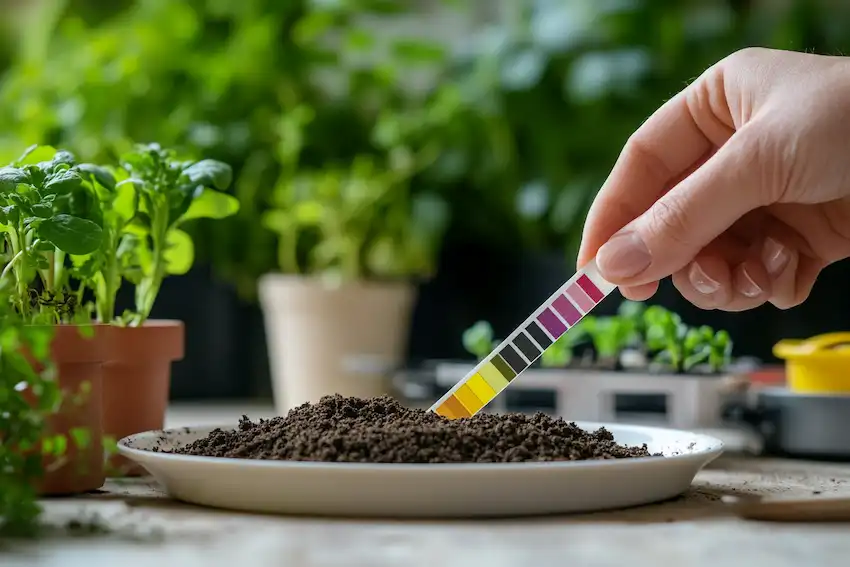Understanding and Managing Soil pH for a Thriving Garden
Soil pH is a critical factor in gardening that affects nutrient availability, microbial activity, and overall plant health. By learning how to test, interpret, and adjust soil pH, you can create optimal conditions for your plants to thrive. Here’s a comprehensive guide to understanding and managing soil pH.
What is Soil pH and Why Is It Important?
Soil pH measures the acidity or alkalinity of the soil on a scale from 0 to 14:
- Neutral Soil (pH ≈ 7): Ideal for most plants as it provides balanced nutrient availability.
- Acidic Soil (pH < 7): Common in high-rainfall areas; can cause nutrient deficiencies in phosphorus, calcium, and magnesium but enriches soil with iron and manganese.
- Alkaline Soil (pH > 7): Often found in arid regions; rich in calcium and magnesium but may lack iron, zinc, and phosphorus, affecting plant growth.
Understanding soil pH helps you make informed decisions about plant selection and soil amendments.
Step 1: Test Your Soil pH
1. Soil pH Testing Kits
- Purchase Kits: Available at garden centers or online, these kits come with pH test strips or meters.
- Follow Instructions: Ensure accurate results by adhering to the kit’s guidelines.
2. Professional Testing
- Local Services: Send soil samples to agricultural extension services or soil testing labs for a detailed analysis, including pH and nutrient levels.
3. DIY Testing
- Vinegar and Baking Soda: For a rough estimate, mix soil samples with vinegar and baking soda. Fizzing with vinegar indicates alkaline soil, while fizzing with baking soda suggests acidic soil.
Step 2: Understand pH Levels and Their Impact on Plants
1. Acid-Loving Plants (pH 4.5-6.0)
- Examples: Blueberries, azaleas, rhododendrons, and hydrangeas.
- Planting Tip: These plants thrive in naturally acidic soil with minimal amendments.
2. Neutral to Slightly Acidic Plants (pH 6.0-7.0)
- Examples: Most vegetables, herbs, and flowers like tomatoes, cucumbers, beans, and roses.
- Planting Tip: Ideal for a wide range of garden plants, requiring less soil adjustment.
3. Alkaline-Tolerant Plants (pH 7.0-8.5)
- Examples: Lavender, asparagus, and lilacs.
- Planting Tip: Select plants that naturally tolerate or prefer alkaline conditions.
Step 3: Adjusting Soil pH
1. Lowering Soil pH (Making It More Acidic)
- Sulfur: Apply elemental sulfur to gradually lower pH. Follow package directions and be patient, as changes can take several months.
- Organic Matter: Incorporate compost, peat moss, or pine needles to naturally acidify soil.
- Aluminum Sulfate: Effective for quick pH reduction but use sparingly to avoid plant damage.
2. Raising Soil pH (Making It More Alkaline)
- Lime: Use agricultural lime (calcium carbonate) or dolomitic lime (contains magnesium) to raise pH. Apply in fall or early spring.
- Wood Ash: Adds potassium and calcium carbonate, raising pH. Use cautiously as it can change pH quickly.
- Baking Soda: For minor adjustments, mix baking soda with water and apply to small areas.
Step 4: Selecting Suitable Plants for Your Soil pH
1. For Acidic Soils:
- Suitable Plants: Blueberries, rhododendrons, camellias, and ferns.
2. For Neutral Soils:
- Suitable Plants: Most garden vegetables, herbs, and flowers.
3. For Alkaline Soils:
- Suitable Plants: Lavender, rosemary, yarrow, and geraniums.
Alternatively, use raised beds or containers with tailored soil mixes for specific plants if soil pH adjustments are impractical.
Step 5: Regular Monitoring and Maintenance
1. Periodic Testing:
- Frequency: Test soil pH annually, preferably in fall or early spring before planting.
2. Seasonal Adjustments:
- Amendments: Apply necessary soil amendments based on test results and observe gradual pH changes.
3. Observe Plant Health:
- Symptoms: Watch for signs like yellowing leaves or stunted growth, which may indicate pH imbalances.
The Role of Soil Microorganisms
1. Beneficial Microbes:
- Impact of pH: pH influences microbial populations that help decompose organic matter and make nutrients available. Acidic soils favor certain microbes, while alkaline soils support others involved in nitrogen fixation.
2. Fungi and Mycorrhizae:
- Nutrient Exchange: Soil pH affects fungal networks, including mycorrhizae, crucial for nutrient uptake. Ensure pH is within the ideal range for optimal fungal activity.
Disclaimer
While adjusting soil pH can enhance plant health, avoid over-adjusting, as it can lead to nutrient imbalances and harm plants. Follow product instructions and consult local experts if unsure about soil needs. This guide provides general advice and should not replace professional consultation.
Achieving Optimal Soil pH for a Thriving Garden
Managing soil pH is essential for a healthy garden. By testing your soil, understanding its pH impact, adjusting as needed, and selecting suitable plants, you can create the best growing conditions. Regular monitoring and thoughtful care will ensure a thriving, productive garden.

